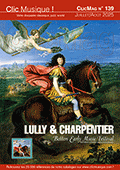|
|
|
Format : 1 CD
Durée totale : 01:05:12
Enregistrement : 2014-2015
Lieu : Santo Stefano Ticino
Pays : Italie
Prise de son : Stereo
Label : Urania
Référence : LDV14023
EAN : 8051773570230
Année d'édition : 2015
Date de sortie : 01/06/2015
Genre : Classique
|
|
 |
Wolfgang Amadeus Mozart (1756-1791)Divertimento n° 2 pour hautbois, clarinette et basson, K. 439 (arr. F. Oubraours) Divertimento pour hautbois, basson et clavecin, K. 252 (arr. C.E. Naumann) Sonate en fa majeur pour hautbois et clavecin, K. 13 Johann Christian Fischer (1733-1800)Duo pour hautbois et basson en sol majeur Joseph Haydn (1732-1809)Trio n° 3 pour hautbois, clarinette, basson et clavecin Italian Classical Consort
Guido Toschi, hautbois
Edmondo Crisafulli, basson
Luigi Magistrelli, clarinette
|
 
 The history of the composition of Mozarts Divertimentos K 439 is quite complicated because we dont have the original manuscript but only some printed editions of the XIXth Century, which were destined to different nstrumental combinations: two clarinets and bassoon, two basset horns and bassoon and even for piano solo, under the name of Viennese Sonatinas. We know for sure that they were originally conceived for three basset horns and divided into 25 separated movements, then put together in order to set 5 Divertimentos. They are delightful instrumental miniatures which can draw the attention of the listener whatever the arrangement is. The Divertimentos K 240 and K 252 by Mozart were originally thought for wind sextet (2 oboes, 2 bassoons and two horns) but for this recording we have used the arrangement of Ernst Naumann (1832-1910), musicologist, conductor, composer and above all arranger of the repertoire of Bach, Mozart and Mendelssohn. These Divertimentos belong to the long list of Serenades and Divertimentos for winds. They are mostly destined to wind octets including clarinets, and they are typical examples of entertainment music. Their light carachter is very amusing and ironical but it also introduces deep feelings within the slow movements. The final part of the Sextet K 525 has a clear quotation from a popular song (It is not possible to stop a cat from catching a mouse). The Sonata K 13 in F major is part of a corpus of six Sonatas for piano (harpsichord) and violin (or flute) and it is also suitable for the oboe, as the performance practice of the time suggests. They are early works composed by Mozart at the age of 8. Their character is simple and concise, but the sign of the mozartian genious and his creative verve is already clear. Johann Fischer, german oboist and composer was in Italy in 1765 studying and improving his skills with the great solo player A. Besozzi. In 1786-87, he was in Austria where Mozart heard him after composing the 12 Piano Variations K 179 (1774) on the theme of a minuet of the same Fischer. After returning back to London, during the performance of a concert, he had a fainting fit and died in 1800. He wrote 9 oboe Concertos (3 of them were arranged for harpsichord or fortepiano supposedly by J. C. Bach), many Divertimentos and Sonatas for flute, and this nice Duet for oboe and bassoon we have recorded in this CD. Haydns composition belongs to a series of three Trios for clarinet, violin and cello of which we have a manuscript (not autographed by the composer) that bears the indication for Clarinet dAmour in b flat, violin and cello. This Trio has the typical classical writing in the formal structure and in the lightness of the lovely themes. My collegues and I thought to add the harpsichord to the original instrumental combination, as already conceived in the arrangements of the Mozarts Divertimentos K 240 and K 252, in order to create a better melding and enrich the timbrical color palette.
 |
| . |
 |
|
|
